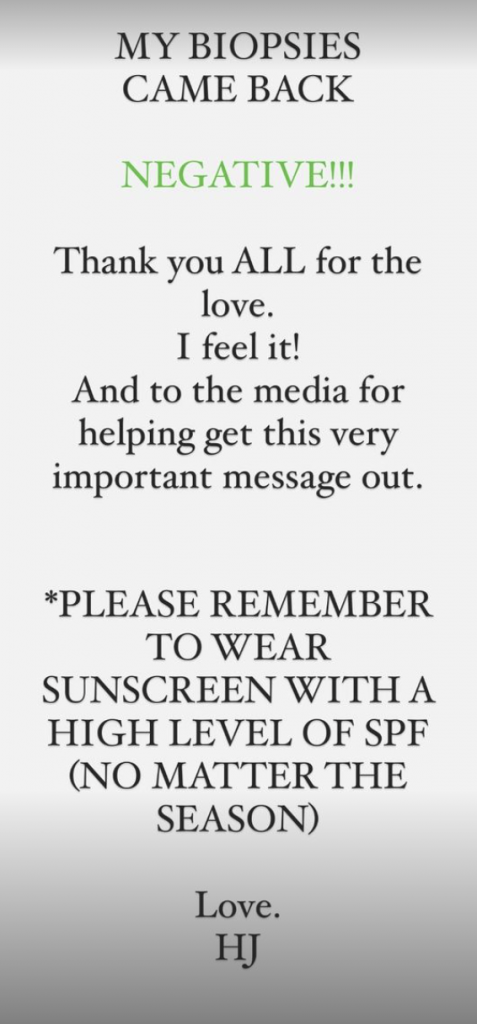Recognizing Basal Cell Carcinoma
- Hugh Jackman, a six time skin cancer survivor, recently had biospies to check for basal cell carcinoma skin cancer. The tests came back negative.
- Basal cell carcinoma is the most common form of skin cancer.
- It is important to treat BCC early because, while it is highly curable and typically slow growing, lesions can grow and become disfiguring and dangerous.
- BCC can often be overlooked as a pimple or skin tag. The lesions can look like open sores, red patches, pink growths, shiny bumps, scars or growths with slightly elevated, rolled edges and/or a central indentation. These spots may ooze, crust, itch or bleed.
Jackman was tested for basal cell carcinoma (BCC), but thankfully the results were negative. But after having developed skin cancer on his face several different times in the past, his message of skin protection is still incredibly important.
Read MoreView this post on Instagram
"Just to remind you, basal cell, in the world of skin cancers, is the least dangerous of them all," he said. “However, if I can just take this opportunity to remind you, summer is coming. For those of us here in the Northern Hemisphere, please wear sunscreen. It is just not worth it. No matter how much you want a tan. Trust me, trust me, trust me. This is all stuff that happened 25 years ago [that] is coming out now.”

Hugh Jackman’s History With Skin Cancer
We’re happy to report Hugh Jackman’s negative biopsy results, but, unfortunately, he is no stranger to cancer. He was first diagnosed with skin cancer in 2013, and it was a relentless battle from there.
"It's always a bit of a shock just hearing the word cancer," he previously told People. "Being an Australian it's a very common thing. I never wore sunscreen growing up so I was a prime candidate for it."
Jackman has reportedly received treatment for skin cancer on his nose six different times. But SurvivorNet is happy to hear Jackman’s latest health announcement and thanks him for his work to educate his many fans about skin cancer protection.
Skin Cancer Protection
How Dangerous Is Basal Cell Carcinoma?
Basal cell carcinoma, or BCC, is the most common form of skin cancer. It develops when basal cells, one of three main types of cells in the top layer of the skin, grow abnormally or uncontrollably. In the United States, an estimated 3.6 million cases of BCC are diagnosed each year.
BCC is unique because it tends to grow slowly. This means it generally causes minimal damage and is usually curable when caught and treated early. Still, untreated BCC lesions can grow and become disfiguring and dangerous.
"Untreated BCCs can become locally invasive, grow wide and deep into the skin and destroy skin, tissue and bone," the Skin Cancer Foundation website says. "The longer you wait to get treatment, the more likely it is that the BCC will recur, sometimes repeatedly.
"There are some highly unusual, aggressive cases when BCC spreads to other parts of the body. In even rarer instances, this type of BCC can become life-threatening."
Mohs Surgery Removes Skin Cancer With Smaller Incisions and More Certainty
There are some “highly unusual, aggressive cases when BCC spreads to other parts of the body.” Rarer cases of aggressive BCC can even become life-threatening.
Still, BCCs rarely spread beyond the original tumor site. But the longer treatment is delayed, the more likely it is that the BCC will recur, sometimes repeatedly. That’s why we stress the importance of treating BCC and treating it early. This can prove difficult, however, because BCC can often disguise itself as a pimple or skin tag.
The Skin Cancer Foundation says they can look like open sores, red patches, pink growths, shiny bumps, scars or growths with slightly elevated, rolled edges and/or a central indentation. The spots can ooze, crust, itch or bleed, and spots on people with darker skin can be pigmented (brown in color).
If you ever find yourself noticing a spot on your skin that seems abnormal for you, make sure to bring it up with your doctor. BCC can vary from person to person, so it’s always a good idea to pay attention to your skin, confront your doctor about anything questionable and prioritize checkups with a dermatologist.
Five Ways to Protect Yourself From Skin Cancer
Skin cancer can happen to anyone and develop at any time of year. It tends to occur on parts of the body that see more sun like the face, head, neck and arms, but it can also develop anywhere including places like the bottoms of your feet, your genitals and the inside of your mouth.
If you’re wanting to minimize your risk of developing skin cancer, check out these tips from Dr. Dendy Engelman, a board certified dermatologic surgeon at Shafer Clinic Fifth Avenue.
Top 5 Ways to Protect Your Skin From Skin Cancer
- Avoid sun during peak hours: 10 a.m. to 2 p.m.
- Wear a wide brimmed hat and sunglasses to protect the tops of our heads, the tops of our ears and the delicate area around the eye.
- Wear at least SPF 30 sunscreen and make sure to reapply every two hours or after excessive sweating or swimming.
- Have yearly skin checks (with a professional) because it's difficult to evaluate areas all over the body.
- Avoid tanning beds. There are no "good" tanning beds, and they can significantly increase your risk of skin cancer.
In addition, make sure to prioritize skin protection all year round. People often focus on things like sunscreen use solely in the summer, but our experts know skin damage can happen at any time of the year.
RELATED: Choose the Right Sunscreen and Use It Often
"My patients ask me all the time, 'Do I really need sunscreen every day, all year round?' The answer is yes," Dr. Engelman told SurvivorNet. "People think they only need sun protection when they're in the bright, warm sunshine. But the reality is, we can get sun damage at any time throughout the year, even in the cold, wintry months. Think about when you go skiing. That's a very high risk. Even though it's cold, our skin should be protected."
Which Sunscreen Should I Choose To Prevent Cancer?
Learn more about SurvivorNet's rigorous medical review process.

